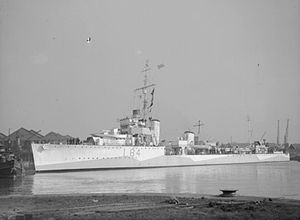HMS Keppel (D84)

HMS Keppel, in 1943
|
|
| History | |
|---|---|
|
|
|
| Name: | HMS Keppel |
| Namesake: | Augustus Keppel |
| Ordered: | April 1918 |
| Builder: | John I. Thornycroft & Company |
| Laid down: | October 1918 |
| Launched: | 23 April 1920 |
| Commissioned: | 15 April 1925 |
| Recommissioned: | August 1939 |
| Fate: | Discarded 1945, Scrapped |
| General characteristics | |
| Class and type: | Thornycroft type destroyer leader |
| Displacement: |
|
| Length: | |
| Beam: | 31 ft 6 in (9.60 m) |
| Draught: | 12 ft 3 in (3.73 m) |
| Installed power: | 40,000 shp (30,000 kW) |
| Propulsion: |
|
| Speed: | 38 kn (44 mph; 70 km/h) |
| Capacity: | 500 short tons (450 t) fuel oil |
| Complement: | 164 |
| Armament: | 5 × BL 4.7 in (120 mm) Mark I dual purpose gun, 1 × QF 3 inch 20 cwt anti-aircraft gun, 6 × 21 in (533 mm) torpedo tubes (2 × 3) |
| Service record | |
HMS Keppel was a Thornycroft type flotilla leader built for the Royal Navy at the end of the First World War. She was completed too late to serve in that conflict, but saw extensive service in the inter war years and in World War II. She was an effective convoy escort and U-boat killer, being credited with the destruction of five U-boats during the Battle of the Atlantic. She was the second of three ships named for 18th century Admiral Augustus Keppel.
Keppel was one of five ships of this class built as flotilla leaders by J I Thornycroft of Woolston, Hampshire to their own design. In this she was similar to the Admiralty's destroyer leader type, but built with features specific to Thornycroft's design principles. Keppel was ordered in April 1918 and laid down in October that year, but the war ended shortly after and work slowed with the advent of peace. Keppel was launched in April 1920 and moved to the Royal Navy Dockyard at Portsmouth, and later to Pembroke, where she was finally completed in April 1925.
After commissioning Keppel served on various stations in the inter-war period, in the Mediterranean and the Far East, before going into reserve in 1937. With war threatening she was re-commissioned in August 1939 and was stationed at Gibraltar as leader of 13th Destroyer Flotilla. In June 1940 she assisted in the evacuation of forces from France, and in Operation Catapult, the attack on the French Fleet at Mers el Kebir. Following this she was returned to Scapa Flow, joining 12th Destroyer Flotilla for fleet operations, such as assisting in fleet escort duty, offensive sweeps in home waters, and preparations to resist the expected German invasion.
...
Wikipedia
